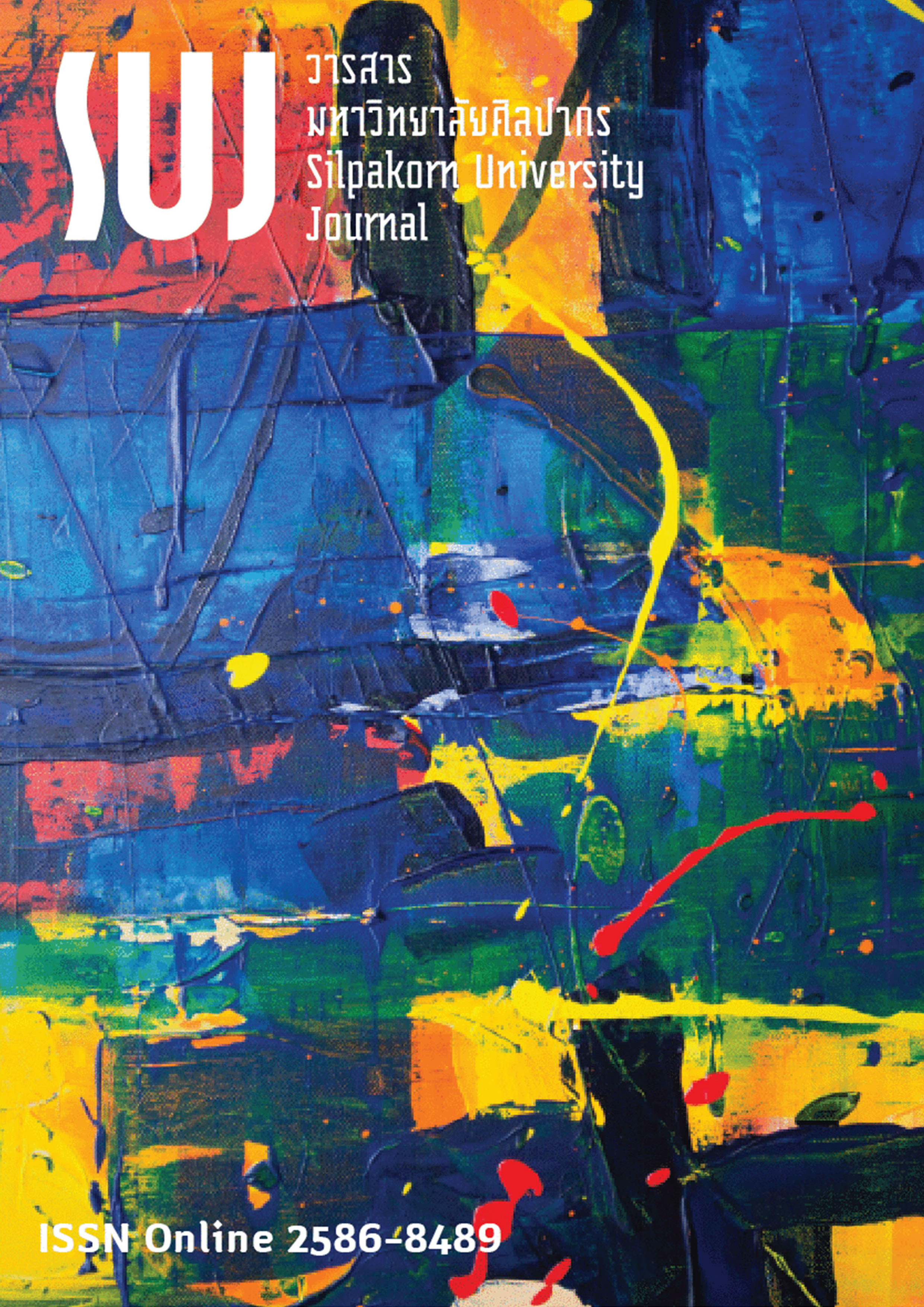รูปแบบการจัดการเรียนรู้ด้วยกลวิธีการกำกับตนเองเพื่อการอ่านอย่างมีวิจารณญาณ (Learning model based on self-regulation strategies to enhance critical reading abilities)
Main Article Content
Abstract
การวิจัยเรื่องนี้มีวัตถุประสงค์ 1) เพื่อพัฒนารูปแบบการจัดการเรียนรู้ด้วยกลวิธีการกำกับตนเอง เพื่อส่งเสริมความสามารถด้านการอ่านอย่างมีวิจารณญาณระดับมัธยมศึกษาปีที่ 3 ในโรงเรียนนานาชาติ 2) เพื่อประเมินประสิทธิผลรูปแบบการจัดการเรียนรู้ ประกอบด้วย การประเมินความสามารถด้านการอ่านอย่างมีวิจารณญาณของนักเรียนก่อนและหลัง และการประเมินความพึงพอใจของนักเรียนที่มีต่อรูปแบบการจัดการเรียนรู้ โดยใช้กลุ่มตัวอย่าง จำนวน 12 คน ใช้วิธีการเลือกกลุ่มตัวอย่างแบบกลุ่ม (cluster sampling) โดยใช้เวลาการทดลอง 7 สัปดาห์ จำนวน 35 ชั่วโมง ผลการศึกษา พบว่า รูปแบบการจัดการเรียนรู้ ประกอบด้วย หลักการ วัตถุประสงค์ กระบวนการจัดการเรียนรู้ และการวัดและประเมินผล โดยมีกระบวนการจัดการเรียนรู้ 4 ขั้นตอน คือ ขั้นสร้างเป้าหมาย เป็นการสร้างแรงจูงใจในการทำงานด้วยการสร้างเป้าหมายทั้งระยะสั้นและระยะยาว ขั้นคำถามชวนคิด เป็นการตั้งคำถามและตอบที่เสริมสร้างองค์ความรู้ ขั้นตกผลึกการอ่าน เป็นการเรียนรู้ที่จะใช้กลวิธีในการอ่านอย่างหลากหลาย และขั้นสะท้อนความคิด เป็นการแสดงความคิดเห็นและตัดสินผลงานของผู้อื่น โดยในการวิจัยใช้ค่าสถิติทดสอบ Nonparametric statistics แบบ Wilcoxon signed rank test มีค่าเท่ากับ -3.066 การประเมินความพึงพอใจต่อรูปแบบการจัดการเรียนรู้ในภาพรวม มีความพึงพอใจในระดับมาก ซึ่งส่งผลให้เกิดการพัฒนาตนเองในการทำงานและการอ่านอย่างมีวิจารณญาณ ผลการวิจัยจะเป็นแนวทางในการจัดการเรียนรู้ที่ช่วยส่งเสริมให้ผู้เรียนเกิดการกำกับตนเองหรือกระตุ้นตนเองในการเรียนรู้ รวมไปถึงการปรับเปลี่ยนกลยุทธ์ในกระบวนการจัดการเรียนรู้ที่มีความทันสมัยเหมาะสมกับโลกยุคปัจจุบัน รวมไปถึงสามารถพัฒนาตนเองและเกิดการเรียนรู้ตลอดชีวิต
This research aims to: 1) develop a self-directed learning management model to enhance the critical reading abilities of Mathayom 3 students at an international school, and 2) evaluate the effectiveness of the learning management model, including assessing students' critical reading abilities before and after implementation, as well as evaluating student satisfaction with the learning management model. Using a sample group of 12 individuals, the study employed a cluster sampling method, with an experimental duration of 7 weeks and a total of 35 hours. The study’s results revealed that the learning management model consists of principles, objectives, learning processes, and assessment methods. The learning process consists of 4 stages: the goal-setting process which is about creating motivation in work by establishing both short-term and long-term objectives, the questioning stage which encourages thought by posing questions and providing answers that enhance knowledge, the reading comprehension stage involving learning through diverse reading methods, and the reflection stage that involves expressing opinions and evaluating the work of others. This research utilized nonparametric statistics, specifically the Wilcoxon signed-rank test, with a value of -3.066. The assessment of satisfaction with the overall learning management approach is highly satisfactory, leading to personal development in both work and reading, with discernment. The research findings will serve as guidelines for a learning management approach that facilitates self-regulation and self-stimulation in learners’ educational journeys. This encompasses adapting strategies within the learning process to remain relevant and appropriate in today’s world. Additionally, it enables personal development and lifelong learning.
Downloads
Article Details

This work is licensed under a Creative Commons Attribution-NonCommercial-NoDerivatives 4.0 International License.
References
Anderson. N. (1999). Exploring Second Language Reading: Issues and Strategies. Boston, MA: Heinle & Heinle.
Bandura, A. (1986). Social Foundations of Thought and Action. Upper Saddle River, NJ: Prentice Hall.
Bowornwattanaset, Chaiwat. (2016). Instructional strategies based on scaffolding theory (ยุทธศาสตร์การจัดการเรียนการสอนตามทฤษฎีการเสริมต่อการเรียนรู้). Prae-wa Kalasin Journal of Kalasin University, 3(2): 154-179.
Efklides, A. (2011). Interactions of metacognition with motivation and affect in self-regulated learning: The MASRL model. Educational Psychologist, 46(1): 6-25.
Grabinger, S., Aplin, C., & Ponnappa-Brenner, G. (2007). Instructional design for sociocultural learning environments. E-Journal of Instructional Science and Technology, 10(1): 1-16.
Hadwin, A. F., & Järvelä, S. (2011). Self-Regulated, Co-Regulated, and Socially Shared Regulation of Learning. In B. J. Zimmerman & D. H. Schunk (Eds.), Handbook of Self-Regulation of Learning and Performance, (pp. 65-84). New York: Routledge.
Harris, T. L., & Hodges, R. E. (1981). A Dictionary of Reading and Related Terms. Newark, DE: International Reading Association.
Kaenin, Theeraphong. (2011). Socratic method of teaching (วิธีสอนแบบโสเครติส). Journal of Education, Prince of Songkla University, Pattani Campus, 22(2): 156-166.
Kruse, K. (2009). Introduction to Instructional Design and the ADDIE Model. [Online]. Retrieved February 27, 2020 from https://portal.ct.gov/-/media/CTDN/TtT2015/ttt2015module5IntroInstDesignADDIEpdf.pdf
Nugteren, M. L., Jarodzka, H., Kester, L., & Van Merriënboer, J. J. G. (2018). Self-regulation of secondary school students: Self-assessment are inaccurate and insufficiently used for learning-task selection. Instructional Science, 46(3): 357-381.
Pintrich, P. R. (1999). The role of motivation in promoting and sustaining self-regulated learning. International Journal of Educational Research, 31(6): 459-470.
Pintrich, P. R. (2004). A conceptual framework for assessing motivation and self-regulated learning in college students. Educational Psychology Review, 16(4): 385-407.
Schuck, D. H. (2008). Metacognition, self-regulation, and self-regulated learning: Research recommendations. Educational Psychology Review, 20(4): 463-467.
Vygotsky, L. S. (1976). Education Psychology. Florida: St. Lucie Press.
Wallace, M., & Wray, A. (2011). Critical Reading and Writing for Postgraduates (2nd ed.). London: SAGE Publications.
Winne, P. H., & Hadwin, A. F. (1998). Studying as Self-Regulated Engagement in Learning. In D. J. Hacker, J. Dunlosky, & A. C. Graesser (Eds.), Metacognition in Educational Theory and Practice, (pp. 277-304). Hillsdale, NJ: Lawrence Erlbaum.
Xiao, Y., & Yang, M. (2019). Formative assessment and self-regulated learning: How formative assessment supports students’ self-regulation in English language learning. System, 81: 39-49.
Yindeesug, Sarunporn. (2014). Development of a Social Studies Instructional Model Based on Interactive-Constructivist Approach and Self-Regulation to Enhance Critical Thinking and Curiosity of Upper Secondary School Students (การพัฒนารูปแบบการเรียนการสอนสังคมศึกษาตามแนวคิดอินเตอร์แอกทีฟคอนสตรักติวิสต์และการกำกับตนเองเพื่อส่งเสริมการคิดอย่างมีวิจารณญาณและความใฝ่รู้ของผู้เรียนชั้นมัธยมศึกษาตอนปลาย). Doctoral dissertation, Chulalongkorn University, Bangkok, Thailand.
Zimmerman, B. J. (1990). Self-regulated learning and academic achievement: An overview. Educational Psychologist, 25(1): 3-17.


